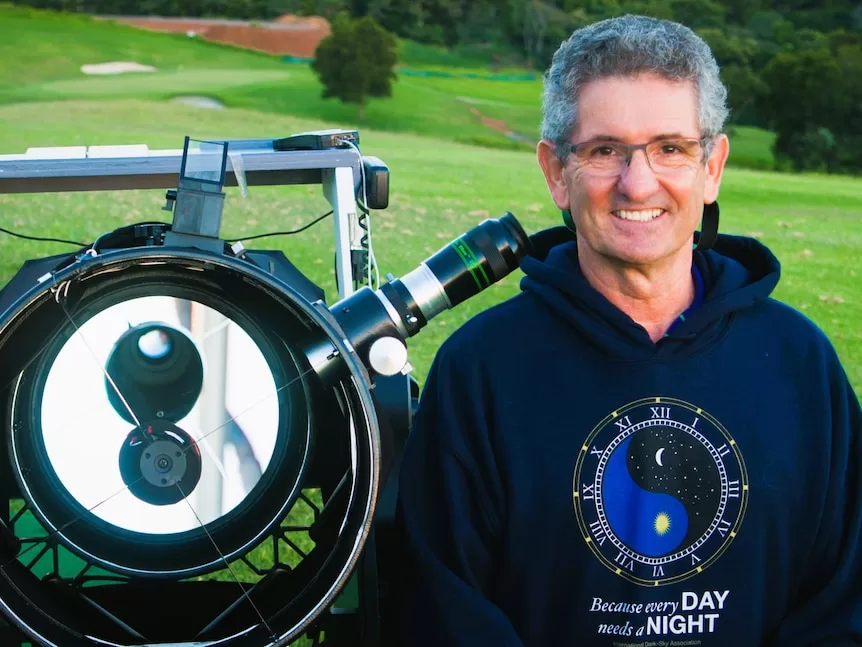- In short: The Sunshine Coast Council is considering a proposal for the hinterland to become a Dark Sky Reserve.
- Advocates say the move would attract stargazing tourists and protect the environment by limiting light pollution, with minimal impact on residents.
- What’s next? The council is taking public submissions on the proposal.
A Queensland region renowned for its multi-million-dollar wedding industry hopes to add stargazing to its tourism drawcard.
A proposal to establish a Dark Sky Reserve in the Sunshine Coast hinterland through the International Dark Sky Places Program is being considered by the local council.
A Dark Sky Reserve protects night skies through responsible lighting and public education.
There are only five “dark sky places” in Australia and if the Sunshine Coast hinterland was accepted, local businesses believe it would attract national and international astro-tourism visitors.
The proposed reserve spans the Mary River catchment area and encompasses the townships of Maleny, Mapleton, Montville, Witta, Flaxton, Conondale, and Kenilworth.
Astronomers say, in the Obi Obi Valley, the Milky Way can sometimes be so bright it casts a shadow.
Astronomer Ken Wishaw, a passionate stargazer and convener of the Maleny Observatory for the Brisbane Astronomical Society, says the mapped reserve offers prime locations for stargazing and astronomical studies.
“The hinterland skies are quite a spectacular thing to see,” Dr Wishaw says.
Sunshine Coast Councillor Winston Johnston says, being near airports, the hinterland has a unique advantage to draw tourists eager for a stargazing experience.
Nearly all the other reserves are in remote areas, making them harder and more expensive to reach, he says.
“People from heavily light-polluted areas are often amazed by the stars they can see here.
“It’s something that many have never experienced before.”
Dr Wishaw, who is also on the board of the Australasian Dark Sky Alliance, has witnessed an increase in astrotourism over the past five years.
Through the Maleny Observatory’s 14-inch telescopes, you can see 5-kilometre-long craters on the Moon, detail within the rings of Saturn and six of its moons, and galaxies out to 10 million light years.
“Whenever we run public stargazing nights, we get excellent attendance,” Dr Wishaw says.
“Kids love it; people of all ages find it fascinating and educational.
“When they experience truly dark skies, they realise what they’ve been missing.”
Residents’ responsibilities
Dr Wishaw says 80 per cent of the world’s population lives under “skyglow”, which obscures stars at night.
As the Sunshine Coast’s population grows, light pollution is expected to increase, impacting on the quality of its night skies.
Dark Sky Reserves support responsible lighting practices, reducing light pollution and properly managing artificial lighting.
“Light pollution is a huge problem,” Dr Wishaw explains.
“The best way to address this issue is through education and proper lighting practices.”
Both Cr Johnston and Dr Wishaw says Dark Sky Reserve status would have a minimal impact on the 15,000 residents living in the area.
“We’ll be asking them to use LED lights and ensure they have light shields to direct light downwards,” Cr Johnston says.
“Most people we talk to are really excited about it.
“We’re not going to make it compulsory, but we’ll encourage environmentally friendly lighting.”
Cr Johnston says the initiative also has strong environmental benefits.
“Low lighting helps nocturnal animals that tend to avoid bright lights.”
Amateur astronomer Owen Benedict from Wappa Falls Observatory says reducing light pollution would be a win for the environment.
“The environmental aspects outweigh the potential tourism benefits a reserve could bring,” Mr Benedict says.
“Light pollution kills millions of bugs, which birds rely on for food, and that affects flower pollination.
“We need to automate our street lights with available technology.”
Future in astrotourism
On Friday night, a group of eager stargazers bundled up for the inaugural astro-tourism tour under the proposed Dark Sky Reserve.
Lynn Fallon, tour manager of local attraction Mystic Mountain, says the night-sky journey attracted people of all ages and backgrounds.
“The experience changes one’s perspective of the big picture,” Ms Fallon says.
“It’s about slowing down and appreciating the beautiful universe we live in.”
Hinterland Tourism Sunshine Coast president Kerry Brown views the proposed Dark Sky Reserve as a valuable addition to the region.
“We’ve seen a growing interest in astrotourism as families look to getting back to basics due to tougher financial times,” Ms Brown says.
The Sunshine Coast Council has now called for public submissions on the proposal.
“The more people that can support us, the better,” Dr Wishaw says.
“If there’s a lot of community support, it reinforces the direction we’re going.
Dr Wishaw says in a world increasingly brightened by artificial lights, the Sunshine Coast’s Dark Sky Reserve offers hope and a glimpse into the natural wonder of the night sky.
“By making small changes in how we use light, we can ensure that the awe-inspiring beauty of the night sky remains a part of our natural heritage.”
Get our local newsletter, delivered free each Wednesday
